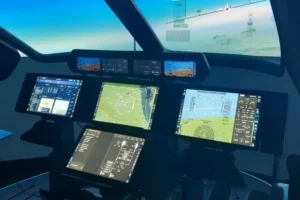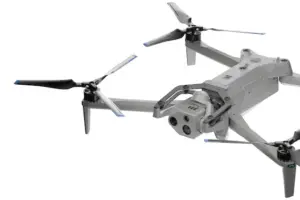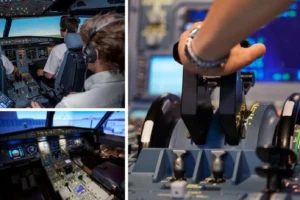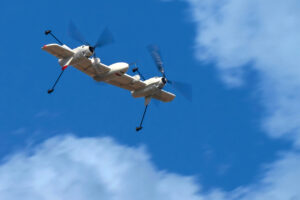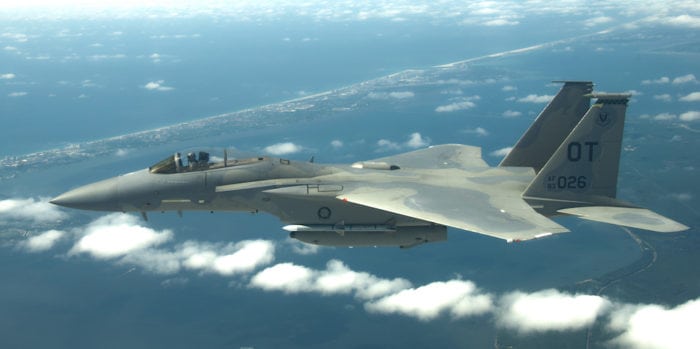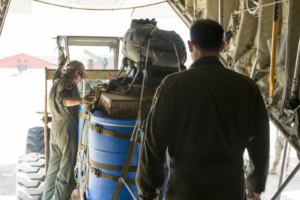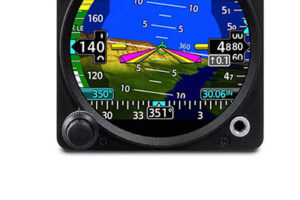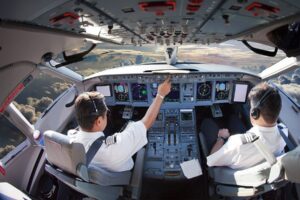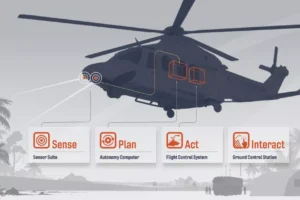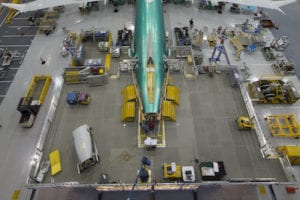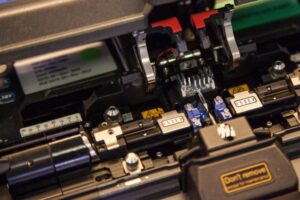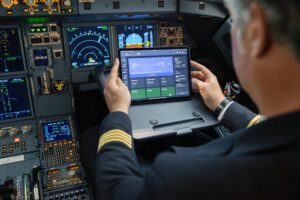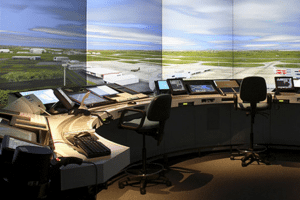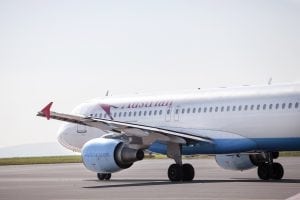Boeing, in conjunction with in-house partner Jeppesen and hardware provider Astronautics Corp. of America, is taking a giant step forward in the march towards a paperless cockpit. The trio has developed a Federal Aviation Administration-certifiable, permanently installed, Class III, electronic flight bag (EFB) to replace up to 77 pounds (35 kg) of manuals on board Boeing 777s (maintenance logs not included), plus another 20 to 40 pounds (9 to 18 kg) of paper carried on board in pilot flight bags. In short, it replaces up to 9,000 pages of paper. The three companies claim the EFB solution, with a cockpit-mounted display, increases efficiency, reduces workload, and adds new tools, such as taxi positional awareness and cabin video surveillance.
In today’s dismal economic conditions, airlines appear to favor EFBs rather than primary flight displays to present taxi positional awareness, aeronautical charting or airline operational information, according to Dan Leger, product manager for Honeywell’s Weather Information Network (WINN), which provides graphical weather information for the cockpit. EFBs also encompass fully portable, Class I, laptop-type computers and Class II, semiportable units, both of which are less costly to certify than Class III equipment.
Nevertheless, Boeing has two customers for the Jeppesen Class III EFB: KLM Royal Dutch Airlines for its new fleet of 10 B777-200ERs and Pakistan Airlines for three of the eight triple sevens it has on order. Boeing plans to have the Class III unit fully certified and ready for delivery to launch customer KLM by October. Boeing is mounting dual 10.4-inch (diagonal) EFB displays on the forward side panels of the B777 cockpit aircraft–one for each pilot.
The manufacturer also will offer a smaller, 8.4-inch version of the Jeppesen EFB for Boeing 737NGs, according to Charles (Chuck) Albright, Boeing program manager for Crew Information Services (CIS). Ultimately, Boeing plans to have an EFB solution for all of its models. The EFB development is part of the CIS group’s effort to employ resources inside and outside of Boeing to launch and implement new information services. This effort included partnering with Jeppesen, which was acquired in July 2000. (Boeing also calls on another subsidiary, FlightSafety Boeing, to provide pilot training input for its EFBs.)
Not a New Idea
EFBs for airline and corporate aviation clients are not new. The transition to paperless flight decks began in the late 1980s, and several avionics suppliers provide them.
"There has been some niche activity with airlines–such as JetBlue, FedEx and Southwest–implementing incremental solutions, such as laptop devices," says Albright. Boeing gained earlier EFB experience with a portable unit for its Boeing Business Jet (BBJ) but is now trying to "implement a total integrated solution… and consolidate the product and service offering to the customer," he explains.
Boeing and its partners are conducting laboratory, ground and flight tests leading up to EFB certification. The CIS group works with the Boeing 777 program to develop and integrate the hardware on board the aircraft and to certify the system and software. Boeing, at its Seattle-area facilities, and Jeppesen, in Denver, are providing the software and developing the applications, while Milwaukee-based Astronautics is providing the display unit (DU) hardware and dual computers, or electronic unit (EU), installed in the electronic equipment (EE) bay.
"Each pilot will have a DU and an EU, and these will talk to one another via an Ethernet," Albright says. Selected electronic charts therefore can be transferred from� one flight crewman to the other. The B777 pilot will select various applications via bezel keys on the display’s perimeter and can also use a cursor control device (CCD) to select options.
Com Compatibility
Boeing is developing the system to allow Class II EFB users to upgrade to a Class III device, which offers a wider range of applications, such as taxi positional awareness. Though more costly, the Class III EFB is compatible with a wider range of communications–including traditional ACARS (aircraft communications addressing and reporting system) channels, VHF, satellite communications, and Connexion by Boeing broadband connectivity.
The Jeppesen EFB hosts applications that replace manuals for aircraft and airline flight operations and training. Its electronic reference library includes flight crew operations and training manuals, a minimum equipment list (MEL), and flight planning and performance manuals. Electronic terminal area charts, using Jeppesen’s worldwide database, include SIDs (standard instrument departures) and STARs (standard terminal arrival routes). CD-ROMs are sent to operators every 14 days to update the Jeppesen chart material. However, Jeppesen officials emphasize that their EFB has "no technical limitations," meaning updates could be made daily if a broadband link is available for the data transfer.
Weight-and-Balance
The EFB also features a weight-and-balance calculator, which applies manufacturer-provided standard computerized airplane performance (SCAP) modules or other performance computational programs to determine precise aircraft speeds and engine settings for takeoff. Factoring in airport and runway conditions due to weather, the calculator helps the pilot set trim and thrust settings, V speeds, and minimum flap retraction altitude, as well as determine landing field and climb performance. Jeppesen’s EFB also displays appropriate notices to airmen (NOTAMs), warning of restrictions.
The EFB’s "charts utilities" page provides quick access to the 10 closest airports, in case an emergency landing is required. The EFB automatically calculates the airports based on the aircraft’s GPS position.
With Jeppesen’s taxi positional awareness (TPA) application, the EFB can enhance pilot situational awareness while taxiing. Using high-definition airport charts and input from the flight management computer or GPS receiver, the pilot can view the aircraft’s exact position on a taxi map. The charts are created from satellite imagery and are accurate to within 10 to 16.4 feet (3 to 5 meters), says Albright.
KLM requires high-definition (or TPA) charts of 11 airports and may receive more, according the Jeppesen officials. By the end of 2004, the EFB software provider plans to have TPA charts for 300 high-use airports worldwide. The EFB database already includes some 37,000 color terminal charts, which can be tailored to serve the operator’s need.
A declutter mode helps simplify maps _for pilots by selectively eliminating geospatial features, such as buildings and other obstacles. Similarly, the presentation of the approach charts can be simplified to include, say, the plan (overhead) view accompanied by the briefing strip, the approach profile, or approach minimums, but not necessarily with all three segments at once. In their entirety, the electronic charts appear just like the paper Jepp charts.
The EFB has pan and zoom features, as well. The pilot can pan the chart or map image by simply touching the screen and dragging a finger. For zooming, the pilot can use the bezel keys or, after pushing the "rectangle zoom" button, press a finger on the top right corner of the desired zoom area, dragging the finger to the bottom left corner. When the finger is lifted, the area it touched will zoom up and fill the screen.
The EFB also hosts video images from a video surveillance system. Pilots can view the flight deck door area from a seated position, a requirement now imposed in Europe, in the wake of Sept. 11, 2001. They can look at split screen images from up to 16 camera locations in the cabin or cargo compartments (January 2003, page 36). Future options have the potential to record images during flight for later retrieval and to downlink images via data link.
At this year’s Paris Air Show, Jeppesen announced that it had signed a memorandum of understanding to provide, as a package, the cabin surveillance system produced by Goodrich Sensor Systems. Jeppesen officials are quick to add, however, that their EFB will interface to other manufacturers’ cabin camera systems.
The electronic logbook (ELB) on Boeing’s EFB allows instant reporting of aircraft faults and offers quick referrals to reference materials. It provides a "fault finder" that allows the flight crew to record a fault, select panels where the fault occurred, or review previous faults.
"The ELB provides information in a common format, so maintenance crew members don’t have to interpret a pilot’s handwriting," says Albright. (Allegedly, the inability to read or interpret pilot handwriting renders some 30 percent of the pilot reports inaccurate.)
Online Weather and Customization
Near-real time weather information also can be overlaid on the EFB map display, depending on the type of connectivity aboard the aircraft. Jeppesen, for example, provides its own weather service from its Los Gatos, Calif., center.
Boeing is designing the EFB with an open architecture, allowing airlines to add their own applications. "You will be able to have multiple channels of connectivity and grow as the airplane grows smarter," Albright says. Data will be delivered to and from the aircraft on the ground, using wireless local area network (LAN) gate links, as well as data loaders. Boeing hopes to add applications, such as controller pilot data link communications (CPDLC), a moving display of the aircraft overlaid on approach charts, and real-time weather.
Astronautics’ Role
Working with Boeing and Jeppesen, Astronautics provides the Boeing EFB’s computer and the display, which it calls the Pilot Information Display (PID). The prototype PID was built in late 2001. (Jeppesen EFB software, however, can be run on other hardware platforms.)
"Boeing, which calls it the EFB, selected our device, modified it, and is offering it as an installation on all new B777s," says Lieb Lotterhos, Astronautics’ PID program manager. "We are building it for Boeing in this case, but we can market it to anyone else."
Boeing’s EFB package includes two Astronautics-built computers. The hardware "isolates certified from non-certified applications," Lotterhos explains. "The moving map on the ground [TPA application] requires certification, but Windows-based applications do not," he adds. (The certifiable software runs on a certifiable version of the Linux operating system.)
"We provide the terminal display unit in front of the pilot–an active matrix LCD [liquid crystal display]. It requires some other transmission device–a radio or satellite receiver–to bring [information] into the airplane, which is sent to our system via ARINC 429 or through Ethernet," says Lotterhos. The display unit "interfaces to communicate with ACARS or the FMS [flight management system]."
Astronautics is not yet offering a portable version of its EFB/PID but, according to Lotterhos, has the capability to do so.


